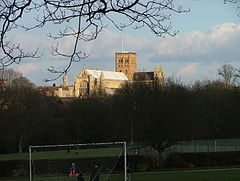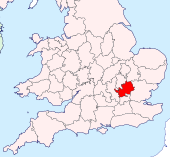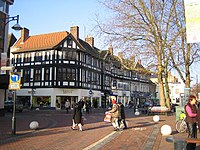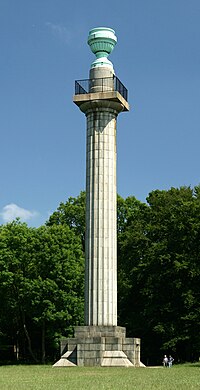Hertfordshire
| Hertfordshire United Kingdom | |
 St Albans Cathedral | |
|---|---|

| |
| Flag | |
| Trust and fear not | |

| |
| [Interactive map] | |
| Area: | 727 square miles |
| Population: | 1,157,166 |
| County town: | Hertford |
| Biggest town: | Watford |
| County flower: | Pasqueflower [1] |
The County of Hertford is an inland shire, considered to be one of the Home Counties. Five counties surround it; Middlesex to the south, Bedfordshire and Cambridgeshire to the north, Buckinghamshire to the west and Essex to the east.
Hertfordshire, lying immediately to the north of the London conurbation and indeed partly within it, has several large towns, in particular in the south of the county. Several major roads, including the M1 and M25 motorways, the A1 and the A10, run through it, whose corridors are marked by urban growth.
High Barnet, New Barnet and Chipping Barnet have been absorbed by the growth of the London conurbation (and indeed with the villages of Totteridge, Arkley and a group of Middlesex towns they have been formed for local government purposes into the London Borough of Barnet).
Away from the towns, the county is marked by low rolling hills, rising in the north and in the west where the Chiltern Hills sweep across the county. The hills at in the north of the county have a steep chalk scarp which forms the boundary with Cambridgeshire.
The highest point in the county is 803 feet above sea level, on the border with Buckinghamshire at the edge of Pavis Wood a quarter mile from the village of Hastoe near Tring.
Hertford, the county town, stands in the east of the county and is its civic centre, while the City of St Albans is its ecclesiastical centre, as the seat of the Diocese of St Albans (which covers Hertfordshire and Bedfordshire) and home of its grand mediaeval cathedral.
As part of a 2002 campaign, the plant conservation charity Plantlife chose the pasqueflower (pulsatilla vulgaris) as Hertfordshire's county flower.
Geography
Geology
The rocks of Hertfordshire belong to the great shallow syncline known as the London Basin. The beds dip in a south-easterly direction towards the syncline's lowest point roughly under the River Thames. The most important formations are the cretaceous chalk, exposed as the high ground in the north and west of the county, forming the Chiltern Hills and the younger palaeocene, Reading Beds and eocene, London clay which occupy the remaining southern part. The eastern half of the county was covered by glaciers during the Ice Age and has a superficial layer of glacial boulder clays.
Natural resources and environment
Despite the spread of built areas, much of the county is given over to agriculture. One distinct product is water-cress, supported by reliable, clean chalk rivers.
Some quarrying of sand and gravel occurs in the St Albans area. In the past, clay has supplied local brick-making and still does in Bovingdon, south-west of Hemel Hempstead. The chalk that is the bedrock of much of the county provides an aquifer that feeds streams and is also exploited to provide water supplies for much of the county and beyond. Chalk has also been used as a building material and, once fired, the resultant lime was spread on agricultural land to improve fertility. The mining of chalk since the early 18th century has left unrecorded underground galleries that occasionally collapse unexpectedly and endanger buildings.[1]
Fresh water is supplied to London from Ware, using the New River built by Hugh Myddleton and opened in 1613. Local rivers, although small, supported developing industries such as paper production at Nash Mills.
Hertfordshire affords habitat for a variety of flora and fauna. One bird common in the shire is the Royston crow, which is the eponymous name of the regional newspaper, the Royston Crow published in Royston.
Towns

History

Hertfordshire was originally the shire assigned to a fortress constructed at Hertford under the rule of Edward the Elder in 913. The name Hertford is derived from the Old English heort ford, literally meaning "hart ford", referring to a ford over the River Lea at that point. The name Hertfordshire first appears in the Anglo-Saxon Chronicle in 1011.
There is evidence of habitation in Hertfordshire since the Middle Stone Age. It was first farmed during the Neolithic period and permanent habitation appeared at the beginning of the Bronze Age.
During the Iron Age tribes settled here and by the first century the area to become Hertfordshire largely fell within the tribal area of the Trinovantes. A large oppidium at Wheathamstead dates from that time, and may have been followed by another at Uerlamion, which gave a name to a later Roman city. After the Roman conquest of Britain beginning in 43 AD, Hertfordshire yielded to Roman trappings; Roman roads were driven across the landscape and one of the Romans' new towns, Verulamium, became the third largest town in Roman Britain.
After the Romans left Britain, the Anglo-Saxons occupied the area, creating their own towns, including the county town of Hertford. Hertfordshire is believed to have been part of the Kingdom of the East Saxons, but was taken into the Kingdom of the Mercians in the sixth century. Hertfordshire was founded as a county probably in the ninth or tenth centuries.
The Norman Conquest in 1066 reached its climax at Berkhamsted where William the Conqueror accepted the final English surrender and forced the boy King Edgar II to submit. After the Norman conquest, Hertfordshire was used for some of the new Norman castles at Bishop's Stortford and at the royal residence of Berkhamsted Castle.
The Domesday Book recorded the county as having nine hundreds:
As London grew, Hertfordshire became conveniently close to the capital; much of the area was owned by the nobility and aristocracy, patronage helped to boost the local economy. However, the greatest boost to Hertfordshire came during the Industrial Revolution, after which the population rose dramatically. In 1903, Letchworth became the world's first garden city. After the Second World War, Stevenage became the first town to redevelop under the New Towns Act 1946. Later it was joined by Hatfield and Hemel Hempstead.
From the 1920s until the late 1980s, the town of Borehamwood was home to one of the major British film studio complexes, including the MGM-British Studios. Many well-known films were made here including the first three Star Wars films. The studios generally used the name of Elstree (the adjoining village). In more recent times, Elstree has had the likes of Big Brother and Who Wants To Be A Millionaire? filmed there, whilst EastEnders is also filmed at the studios. Another Hertfordshire film studio complex is at Leavesden, on the Leavesden Aerodome site. The Harry Potter series was filmed at the studios, whilst the 1996 James Bond film GoldenEye was also filmed there.[2]
In 2012, the town of Waltham Cross hosted the canoe and kayak slalom events of the 2012 Summer Olympic Games.
Following a proposal put forward by The Welwyn Garden Heritage Trust, town-planner Andrés Duany suggested that designated "Garden Villages" could be built within Hertfordshire to relieve some of the pressure for new homes, with perhaps a third Garden City to follow.
Landmarks

Below is a list of places, large and small, to visit in Hertfordshire:
- Aldenham Country Park
- Ashridge estate and house. The Neo Gothic house by James Wyatt, is a Grade 1 listed building (and is not open to the public) but the estate is National Trust land.
- Bridgewater Monument built in 1832 in memory of Francis Egerton, 3rd Duke of Bridgewater. 108feet tall and open to the public to ascend to the top.
- Berkhamsted Castle
- de Havilland Aircraft Heritage Centre, between London Colney and South Mimms
- Gardens of the Rose, Chiswell Green, near St Albans. Home of the Royal National Rose Society
- Hatfield
- Hatfield House – Jacobean house, gardens and park
- Mill Green Watermill in Hatfield
- Henry Moore Foundation, Much Hadham – sculpture park on the work of Henry Moore
- Knebworth House, 250 acres of country park, venue of regular rock and pop festivals.
- Royston Cave in Royston town centre
- St Albans
- Beech Bottom Dyke – large-scale Iron Age defensive or boundary ditch
- St Albans Cathedral
- Verulamium – Roman town remains, including museum of Roman life and the remains of a Roman amphitheatre.
- Ye Olde Fighting Cocks – a claimant to being the oldest pub in Britain
- Scott's Grotto, Ware on the outskirts of town
- Shaw's Corner in Ayot St Lawrence – home of George Bernard Shaw
- Stevenage – the first New Town in Britain
- Six Hills Roman barrows site
- Therfield Heath – a local nature reserve in the north of the county.
- Welwyn Viaduct to the north of Welwyn Garden City.
- Rye House Gatehouse in Hoddesdon (part of the Rye House Plot to assassinate King Charles II).
- Walter Rothschild Zoological Museum, Tring. One of the finest collections of stuffed mammals, birds, reptiles and insects in Britain.
Transport links
Hertfordshire lies across routes between London and the North, the North-West and the Midlands and as a consequence it is well-served by road and rail routes and by canals.
The county has always been traversed by some of the principal roads in Britain, originally the Great North Road to Yorkshire and Edinburgh (now the A1), Watling Street (now the A5) to North Wales, the A6 to Lancashire and the A14 (Sparrows Herne turnpike) to the Midlands and now the M1, M11 and M25 motorways and the A1(M).
Principal rail routes lie through Stevenage to Yorkshire and Edinburgh, and through Watford to the Midlands, north Wales, Lancashire and Glasgow. Lesser routes serve St Albans (and the East Midlands) and Royston (to Cambridge and Norwich). Commuter routes supplement the through routes and the London Underground extends to Watford and to Rickmansworth and Chorleywood on its way to Amersham.
Two international airports lie just outside the county Stansted and Luton.
The Grand Union Canal passes west Hertfordshire, through Watford, Hemel Hempstead and Berkhamsted.
Literature
Hertfordshire finds a place in many books, principally as the place of county residences away from London. Jane Austen's novel Pride and Prejudice is primarily set in Hertfordshire. (Topographical scholars place the town of 'Meryton' either as Hertford or Hemel Hempstead, based on how far Mr Collins travels on the post from Watford. The former location places the Bennet family home Longbourn as the town of Ware.) It is the location of Jack Worthing's country house in Oscar Wilde's play The Importance of Being Earnest.
The eponymous residence in E M Forster's novel, Howards End was based on Rooks Nest House just outside Stevenage. In the novel, Forster describes Hertfordshire as "England at its quietest".[3]
Outside links
| ("Wikimedia Commons" has material about Hertfordshire) |
- GENUKI Hertfordshire Genealogy
- Hertfordshire Genealogy
- Lord Lieutenant of Hertfordshire Website
- Hertfordshire, by Herbert W Tompkins, 1922, from Project Gutenberg
References
- ↑ "About the chalk mines". Dacorum Borough Council. 2008. http://www.dacorum.gov.uk/default.aspx?page=5692. Retrieved 7 Feb 2009.
- ↑ http://www.filmlondon.org.uk/content.asp?CategoryID=836
- ↑ http://www.gutenberg.org/dirs/etext01/hoend10h.htm Gutenberg etext
| Counties of the United Kingdom |
|---|
|
Aberdeen • Anglesey • Angus • Antrim • Argyll • Armagh • Ayr • Banff • Bedford • Berks • Berwick • Brecknock • Buckingham • Bute • Caernarfon • Caithness • Cambridge • Cardigan • Carmarthen • Chester • Clackmannan • Cornwall • Cromarty • Cumberland • Denbigh • Derby • Devon • Dorset • Down • Dumfries • Dunbarton • Durham • East Lothian • Essex • Fermanagh • Fife • Flint • Glamorgan • Gloucester • Hants • Hereford • Hertford • Huntingdon • Inverness • Kent • Kincardine • Kinross • Kirkcudbright • Lanark • Lancaster • Leicester • Lincoln • Londonderry • Merioneth • Middlesex • Midlothian • Monmouth • Montgomery • Moray • Nairn • Norfolk • Northampton • Northumberland • Nottingham • Orkney • Oxford • Peebles • Pembroke • Perth • Radnor • Renfrew • Ross • Roxburgh • Rutland • Selkirk • Shetland • Salop • Somerset • Stafford • Stirling • Suffolk • Surrey • Sussex • Sutherland • Tyrone • Warwick • West Lothian • Westmorland • Wigtown • Wilts • Worcester • York |
